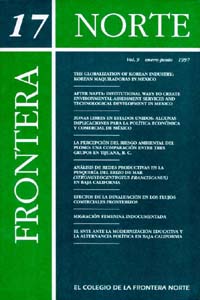After NAFTA: Institutional Ways to Create Environmental Assessment Services and Technological Development in Mexico
Main Article Content
Abstract
Article Details
Authors publishing work in this journal agree to the following conditions:
Authors retain copyright and assign first publication rights to the journal Frontera Norte (RFN), with the texts registered under an Attribution-NonCommercial-NoDerivatives 4.0 International Creative Commons license (CC BY-NC-ND 4.0), which allows third parties to use published material provided they give credit to the authors and acknowledge this journal as the first publisher.
They authorize the reproduction, publication, translation, communication, and transmission of their paper and all accompanying material, publicly and in any form and by any means; its public distribution in as many copies as required; and public communication thereof in any form, including making it available to the public through electronic means or any other technology, and solely for dissemination and scientific, cultural, and non-commercial purposes.
Authors may enter into further independent contractual agreements for the non-exclusive distribution of the version of the paper published in this journal (for instance, to include it in an institutional repository or personal webpage, or publish it in a book), provided it is not for commercial purposes and they clearly state that the work was first published in Frontera Norte (RFN) [and add the corresponding bibliographical record: Author/s (Year). Title of paper. Frontera Norte, volume (number), pp. doi: xxxx].
To that end, authors must submit the form assigning ownership of first publication rights, duly completed and signed. This document is to be uploaded in PDF format as a complementary file on the OJS platform.
This work is released under an Attribution-NonCommercial-NoDerivatives 4.0 International Creative Commons license (CC BY-NC-ND 4.0)..
References
American News Broadcasts, 1993 (commented by). And Reported to the authors by an Interviewee (A), May 5, 1993, in Tijuana.
Business Week, July 6, 1992, page 31.
Bustamante, Rosi. International Volunteer Exchanges Working with Environmental Protection: A Feasibility Study, University of Northern of Iowa, Fall, 1992, page 5.
CILA, 1996.- Comisión Internacional de Límites y Aguas. Personal communication.
City of San Diego. Receiving Waters Monitoring Report 1993. City of San Diego Ocean Monitoring Program. Metropolitan Wastewater Department Environmental Monitoring and Technical Services Division.
Grijalva Palomino I., CESPT, Director of Comisión Estatal de Servicios Públicos de Tijuana, El Mexicano, 14-Feb-1996.
Oceanology Institute at the University Autonomous of Baja California has confirmed the presence of San Diego waste, reported by Interviewee (B).
SEDECO, 1997.- Secretaría de Desarrollo Económico de Baja California. Personal communication.
SEMARNAP, 1994.- Secretaría de Medio Ambiente, Recursos Naturales y Pesca; Diario Oficial de la Federación, 28-Dec-1994.
The International Environmental Reporter, December 15, 1993, page 960.
The San Diego Union Tribune, April 13, 1994, Press for Answers: Mismanagement Hampers Border Sewage Plant.
The Wall Street Journal, "Punishing Polluters", Thursday, September 24, 1993.

